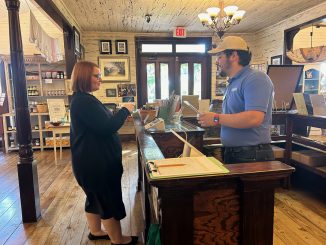
In an effort to raise the spirits of the students at St. Bernard Unified School during the months following Hurricane Katrina, an art teacher drew on an old shrimper tradition and had the students paint a picture describing what Louisiana means to them on a white shrimper’s boot. Working with the Louisiana Seafood Promotion and Marketing Board, St. Charles Parish Harry Hurst Middle Wetland Watchers plan to continue this tradition and use the boots to help others see why Louisiana is important to us and why it may be important to people all across the nation.
Harry Hurst science teacher, Barry Guillot, purchased the boots with funds from the Blue Cross Blue Shield Louisiana Angel Award. Hurst talented Art teacher, John Taube, worked with interested students in creating these unique works of art.
“The boots the students created are just incredible. I think this project is the perfect mix between culture, science and art,” said Guillot.
In fact, the boots are so popular that the Louisiana Art and Science Museum in Baton Rouge has requested a few to be displayed in a permanent exhibit and two are being donated to be displayed at the Audubon Zoo’s Louisiana Swamp exhibit.
Students are also creating boots to be auctioned for many organizations including the restoration of City Park and the LSU AgCenter Master Gardeners Program.
As part of the Wetland Watchers service-learning project awareness goals, many of the boots will be displayed in public libraries around Louisiana and also loaned to different schools across the nation.
Five of the original St. Bernard boots are also displayed with the Hurst students’ boots at all of the Wetland Watcher outreach events.
Often humorously called “Chalmette Reebocks” or “Boudreaux Nikes,” shrimper boots serve as a symbol of Louisiana’s fishing culture which is also an important economic value that depends on Louisiana wetlands. Louisiana historically leads the nation in harvests of shrimp, crabs, menhaden, oysters, and crawfish. According to the USGS, over 75 percent of Louisiana’s commercially harvested seafood is dependent on wetlands. Coastal wetlands provide valuable breeding, spawning, feeding and nursery grounds for many of these species at some point during their life cycles.
“The boots attract the interest of kids and adults and are wonderful conversation starters. I love hearing parents describe to their children what these fancy boots represent,” said Guillot. “Something that I find very interesting is that when people are asked to describe why Louisiana is important to them, most times it is something that relates to Louisiana Wetlands. Coastal land loss is not just a part of Louisiana that is lost – it is a part of who we are.”




Be the first to comment